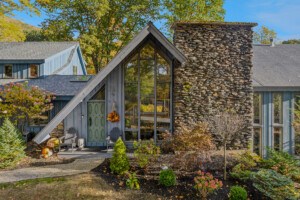A 1930s Brookline Tudor Gets a Resplendent Revival
Kati Curtis Design and ART Architects turn a dated and dreary New England home into a layered haven of brilliance, glory, and surprise.

Photo by Thomas Loof
Architect
ART Architects
Interior Designer
Kati Curtis Design
The initial design directive from the homeowners of this 1930s Brookline Tudor was simple and to the point: No white walls. “I wish all our clients came to us with that dictate,” says designer Kati Curtis, who’d worked with the couple since setting the tone for the wife’s first apartment nearly 20 years ago. “They wanted color everywhere. I loved hearing that.”
Before palette and material selection could begin, the flow of the home needed some serious consideration. After the homeowners purchased the residence—at the suggestion of Curtis, who scoured Zillow in search of a place with soul after they’d presented her with a bland spec house they were considering—ART Architects was brought in to improve the layout.
“Nothing had ever been done to the original layout. The house had been designed when people lived differently,” says J.B. Clancy, one of ART’s partners. “The interior was also very dark and had no relationship to the wonderful backyard. We needed to redefine the plan to suit a 21st-century household.”
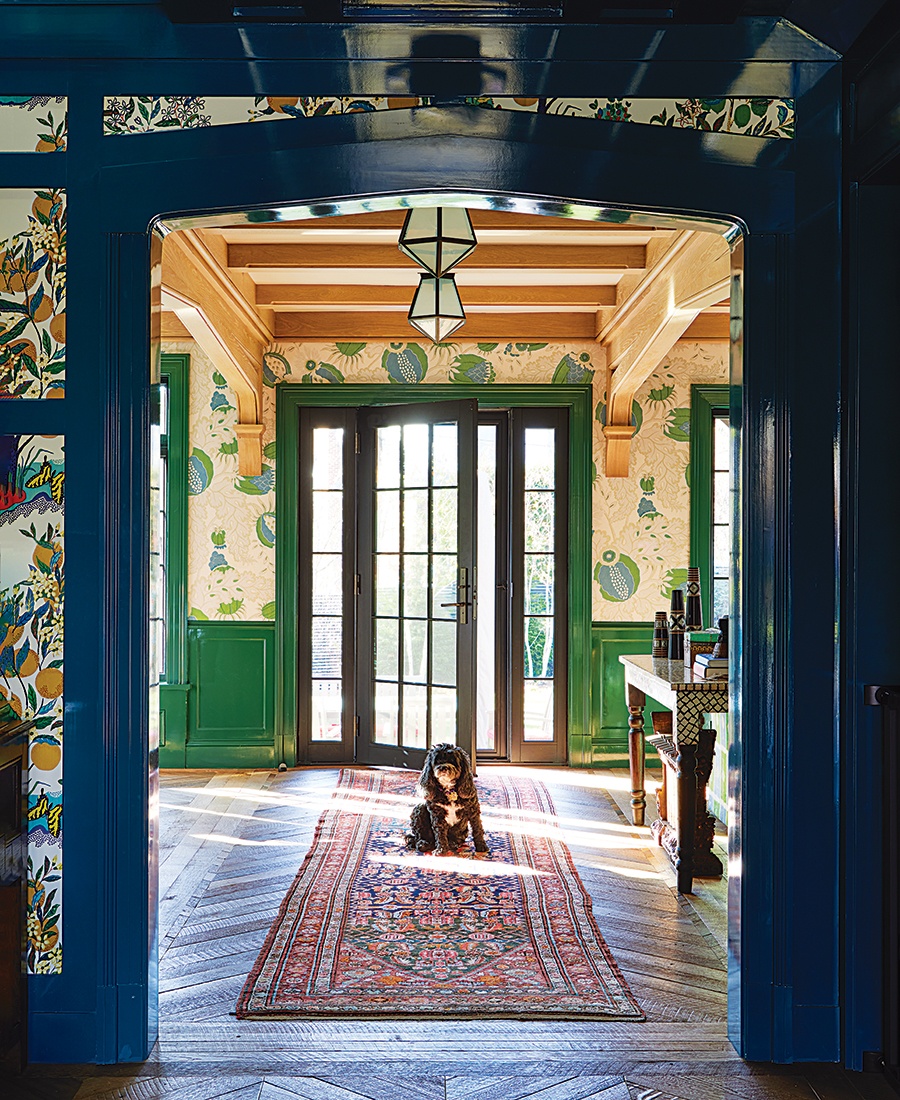
Photo by Thomas Loof
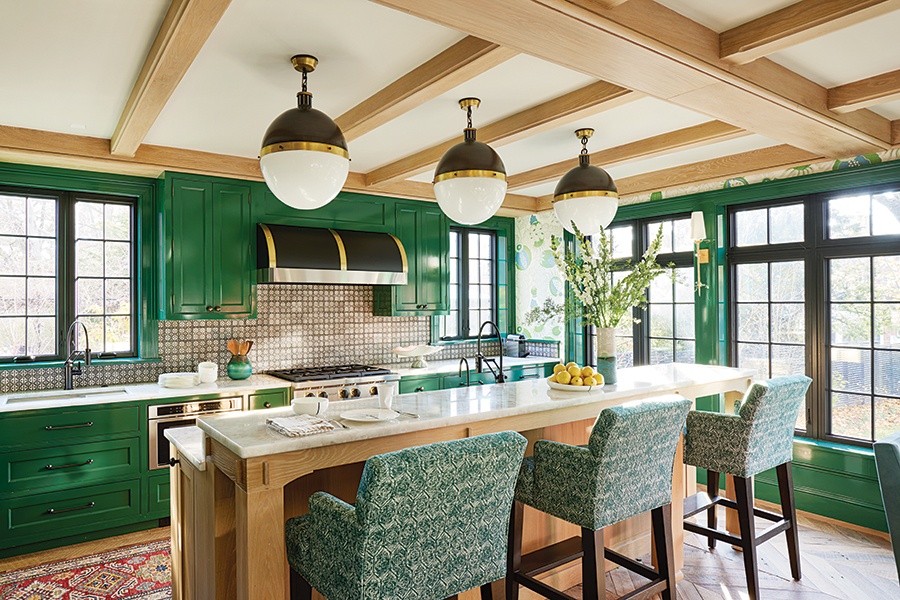
The kitchen’s custom range hood and Circa Lighting pendants feature black and brass detailing that evokes a warm elegance. Stools are upholstered in a green and white Perennials fabric, which pairs well with the white-toned quartzite counters. / Photo by Thomas Loof
To unify the main living spaces, integrate the home with the yard, and bring in more daylight, the floor plan was reconfigured to accommodate the kitchen, dining, and living areas across the back of the house. Ample glass exposures and bay windows that project outward visually connect to the backyard, while glass doors open to a porch that segues to an elevated terrace and beyond to the lawn. These areas encompass one large open space, though Clancy notes that ceiling beams and timber arches were used to define the three different areas.
To bring light into the middle of the home, a new central stairway was designed above the entryway. An atrium—created by puncturing the roof and installing three large custom antique stained-glass skylights—floods light from the second floor all the way down to the basement.
Creating a vibrant and modern interior was key to the homeowners, who have two young children. Equally important was paying homage to the home’s historical vernacular, especially Gothic design elements, which are part of the Tudor language. “Early on, the owners came to us with this idea of ‘Millennial Gothic,’ and we all gravitated to that,” Clancy says. When making design decisions, adds Curtis—from the window casings and door details to lighting and the hand-stamped Moroccan tile—“Interpreting Gothic in a modern way was the anchoring point.”
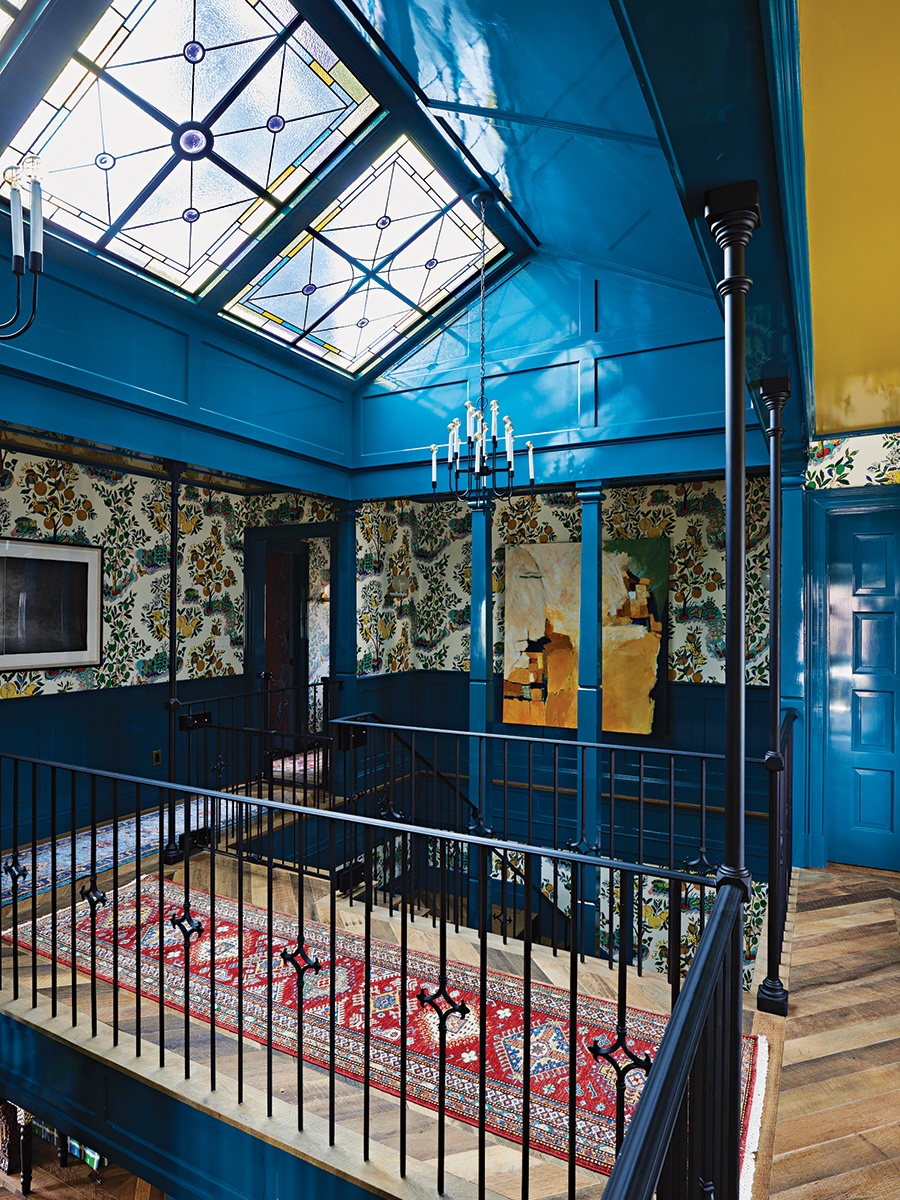
A bridge connects the left and right corridors of the upper level. / Photo by Thomas Loof
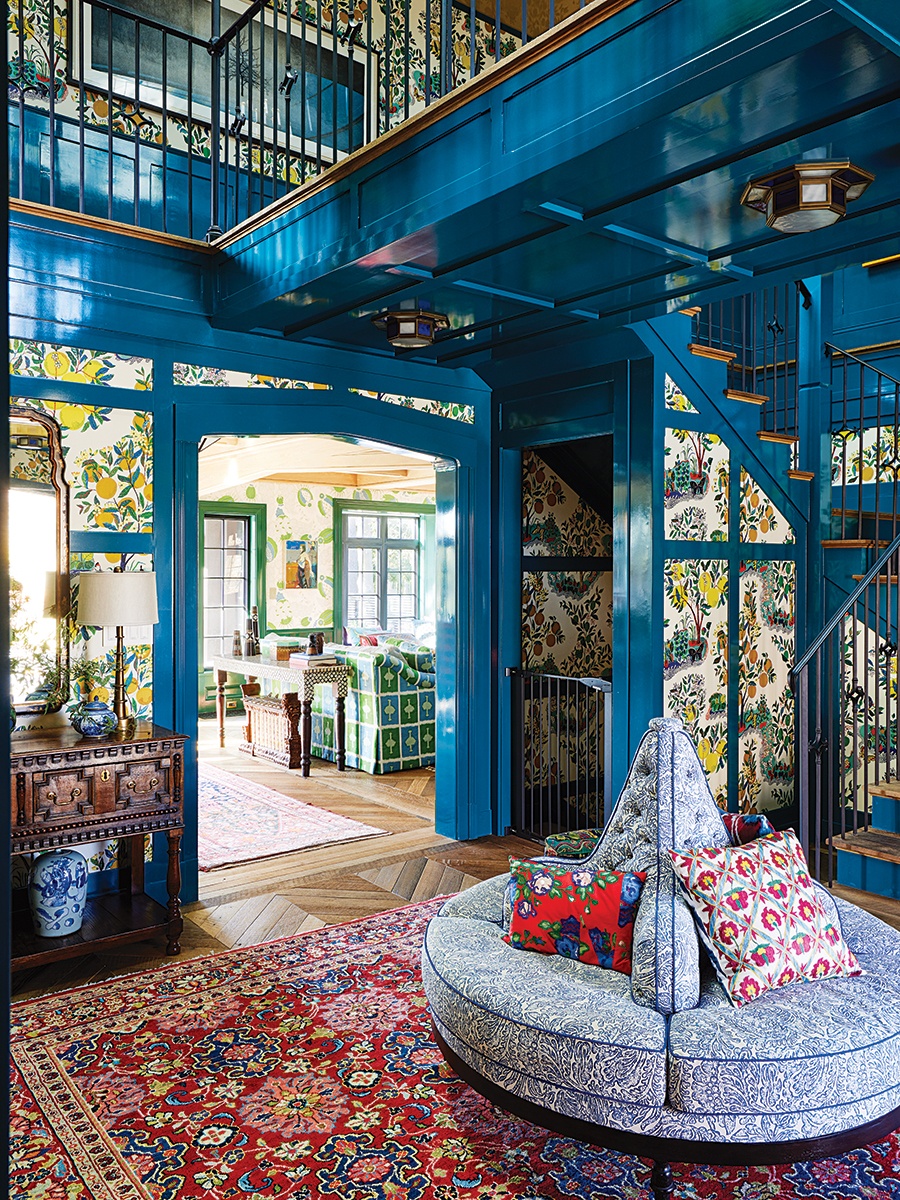
The hallway’s woodwork is painted a custom blue by Fine Paints of Europe, which plays off the blue in the Schumacher wallpaper. The round settee—atop a vintage rug procured from Landry & Arcari—is upholstered in a Jasper fabric that exudes another shade of blue. / Photo by Thomas Loof

Multiple patterns are paired together in the newly created guest room on the lower level; the wallcovering is Osborne & Little. “It’s a dark, pine-green wallpaper that feels like you are inside a magical garden,” Curtis says. The rug is by Wendy Morrison. / Photo by Thomas Loof
Among the first interior design selections was Schumacher’s “Citrus Garden” wallcovering, which sheathes the walls surrounding both levels of the stairway. “I tend to gravitate to lesser-known wallpaper designers, so I wouldn’t normally pick this print because it’s so iconic, but it really had the right scale for this house,” says Curtis, who infused hues from the jubilant pattern along with other saturated tones throughout the home.
The décor comprises vintage pieces, a vivid array of textiles, and art from the homeowner’s collection—along with items from their prior residences that happened to work with the scheme. Most sofas and chairs are upholstered in performance fabric, though you’d never realize that the great-room sofa’s Osborne & Little seat is stain-resistant; ditto on the Christopher Farr wallcovering printed on vinyl. “I believe you don’t have to sacrifice performance for style,” says Curtis, noting that the juxtaposition of styles and materials is at the core of her aesthetic. “It’s all about balance. In the dining room, for example, the table is a rough, antique finish, while there’s a heavier, Gothic chandelier, cerused-oak ceiling beams, and high-gloss painted surfaces all around the room.”
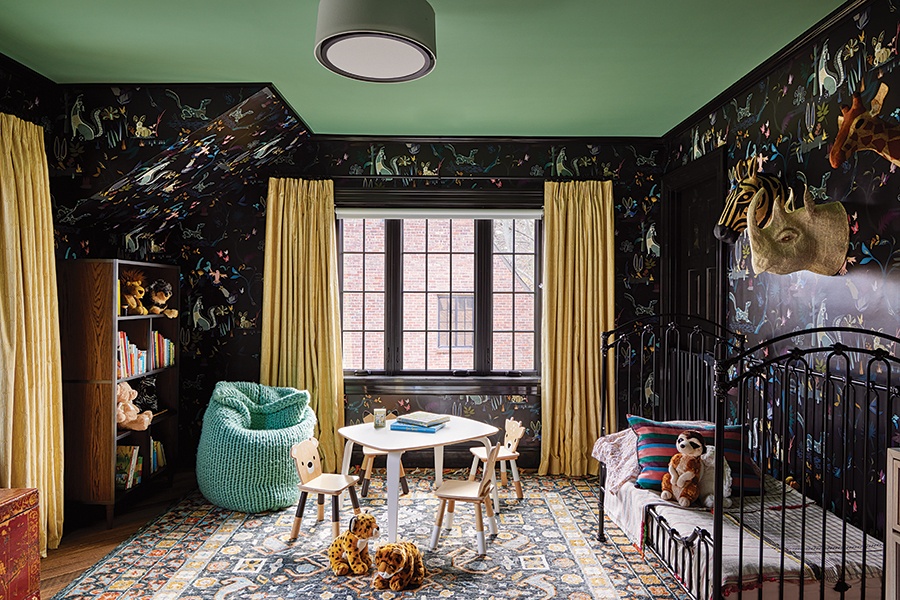
The son’s room features a custom wallcovering by Relativity Textiles. Gold draperies are paired with a Loloi rug, and the ceiling is painted Benjamin Moore “Spring Break.” / Photo by Thomas Loof

In the master bathroom, the trim and vanity are painted a custom Fine Paints of Europe hue, while the walls are Benjamin Moore “Dark Burgundy.” / Photo by Thomas Loof
Among the most captivating elements of the interior is that every painted surface—and there are too many to count—is lacquered to a glorious high sheen with paint from Fine Paints of Europe. “Even though the colors are rich, it doesn’t feel like a dark house because the lacquer finish does an amazing job of passing light around the spaces,” Clancy says.
The lustrous lacquered look is no small feat to achieve, requiring between seven to 10 coats of paint and a tremendous amount of sanding in between. “The painter, Ulisses Matos, had never done this technique, but he jumped right in. It was such a labor of love,” Curtis says, noting that overall, “The whole team was very invested in making this a special home. There was so much pride in the craftspeople who worked on this house; they were there making sure it was perfect.” Indeed, the collective effort shows: This delightfully polished home shines, ready for its next century.

A vintage forged-iron chandelier hangs above the dining table; chairs are upholstered with a luxurious fabric by Anthony George Home on the backs, while the seats are covered with a more durable Designtex upholstery. / Photo by Thomas Loof

Vintage Brutalist bronze chandeliers make a dramatic statement in the playroom, which is housed in the home’s former dining room. The blue floral Brett Design wallcovering appears like a piece of art inset amid the red-painted woodwork. / Photo by Thomas Loof
Everything Is Illuminated
Tailoring a lighting plan that honored the architecture was a big part of the project. “J.B. and I wanted to stay true to the classical style of the house, so we didn’t want to include much downlighting,” Curtis says. The duo only allowed for the installation of a few flange-less overhead lights so they could appear as part of the ceiling. Otherwise, the lighting revolves around decorative and vintage wall sconces and chandeliers. “It was really important to us that those fixtures become the focus, not an overall downlight scheme,” Curtis says.
First published in the print edition of Boston Home’s Spring 2023 issue, with the headline, “Resplendent Revival.”
